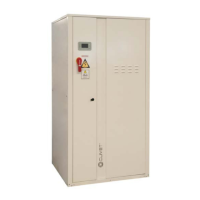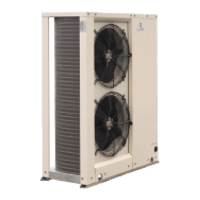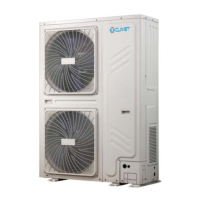Do you have a question about the CLIVET MSAT-XEE 10.2 and is the answer not in the manual?
Provides guidance on correct unit installation, use, and maintenance.
Specifies that only qualified personnel can operate the unit as per regulations.
Highlights potential hazards and necessary precautions during operation.
Defines the specific applications and limitations for unit usage.
Outlines considerations for unit positioning, hydraulics, and electrics.
Emphasizes planning periodic inspections to avoid repair costs.
States that modifications void warranty and manufacturer responsibility.
Instructions for disabling the unit and contacting service agents.
Installer's responsibility to train users on unit operation.
Advises checking the manufacturer's website for updated data.
Guidance on keeping the manual and noting unit interventions.
Explains how to identify unit features using the serial number label.
Highlights the serial number's uniqueness for ordering spare parts.
Information required when requesting technical assistance.
Recommends observing external packaging instructions for storage.
Details on verifying weight, identifying critical points, and lifting safely.
Instructions for careful removal of unit packaging.
Defines necessary clearances for unit operation and maintenance.
Factors to consider when selecting an installation location.
Installer's responsibility regarding drain tubes and safety valves.
Details on the installation of shut-off valves in the refrigerant circuit.
Highlights explosion risk from trapped refrigerant due to temperature increase.
Guidelines for sloping and insulating the suction line.
Requirements for insulating and sizing the liquid line.
Explains the function and placement of the liquid receiver.
Steps for pressurizing and testing the system for refrigerant leaks.
Process for evacuating the refrigerant circuit to remove air and humidity.
Procedure for filling the system with the correct amount of refrigerant.
Guidance on when and how to add oil, especially for long pipes.
Provides data to estimate the required refrigerant quantity.
Details on the Hot Gas Bypass accessory for low-temperature operation.
Information regarding the KCX connection set accessory.
Details on voltage, current, and power input from the serial label.
Instructions for connecting power cables and ensuring safety.
Recommendations for routing control and data cables to avoid interference.
Guidance on fixing power cables and avoiding contact with hot components.
Responsibilities for performing electrical connections by the customer.
Instructions for installing the RCTX remote control.
Installation of the serial communication module with RS485 converter.
Overview of start-up operations performed by qualified technicians.
Essential checks before initiating the unit's start-up sequence.
Detailed chronological steps for starting the unit.
Parameters and checks for the refrigeration circuit during start-up.
Verification of voltage, phase balance, and connections.
Procedure for activating compressor crankcase heaters before start-up.
Monitoring voltages and current absorption during stable operation.
Ensuring remote controls and optional components are connected.
Importance of recording operating conditions during start-up.
Information on compliance with the Pressure Equipment Directive.
Explanation of icons and indicators on the unit's display.
Description of key functions and their actions.
Procedure for activating and confirming the standby mode.
How to navigate through the various menus and settings.
Instructions for turning the unit on and off, including emergency stop.
Procedure for switching between cooling, standby, and off modes.
Steps to set the internal clock and date.
How to view the status of unit inputs and outputs.
Procedure for silencing alarms and identifying their causes.
Listing and explanation of various alarm codes.
Steps for resetting active alarms after their cause is removed.
Accessing and viewing the history of recorded alarms.
Steps to reset the unit's alarm log.
Accessing and modifying configuration parameters.
Configuring programmed operation schedules for the unit.
Details and settings for the optional remote control.
Configuring the unit to display ambient temperature readings.
Importance of maintenance for efficiency and lifespan.
Recommended intervals for performing unit inspections.
Advises creating a booklet to record unit interventions.
Safety precautions regarding electrical voltage during checks.
Procedures for long periods of unit inactivity and re-start.
Specific instructions regarding the compressor supply line shut-off valve.
Comprehensive list of checks for the control system components.
Procedure for cleaning the air heat exchanger fins.
Inspection of fans, bearings, and terminal covers.
Steps for safely disconnecting the unit from services.
Procedures for unit dismantling and disposal at authorized centers.
Information on handling waste electrical and electronic equipment.
Risks associated with electrical components and connections.
Risks of injury from contact with moving mechanical parts.
Dangers associated with refrigerant leaks, pressure, and heat.
Risks related to leaks or projections from hydraulic components.
Physical dimensions and weight specifications for specific unit sizes.
Physical dimensions and weight specifications for specific unit sizes.
Physical dimensions and weight specifications for specific unit sizes.
Overview of cooling capacity, power input, EER, and compressor details.
Information on sound pressure and power levels under various conditions.
Graphical representation of unit operating limits based on temperature.
Details on the optional remote control unit and its installation.
Information on the serial communication module for supervisory systems.
Description of the Hot Gas Bypass accessory for low-temperature operation.
Indicative scheme for installing the KCX connection set components.
Detailed list of alarm codes, their descriptions, and types.
Information on unit status signals, including analog and digital inputs/outputs.











